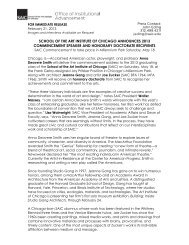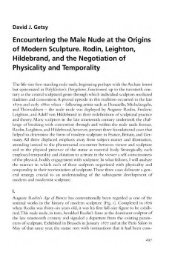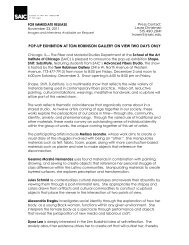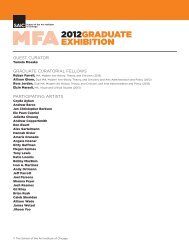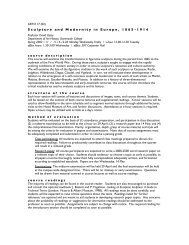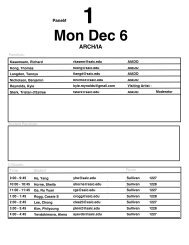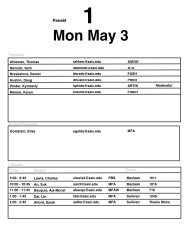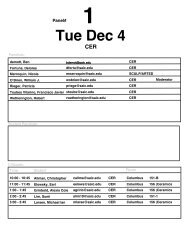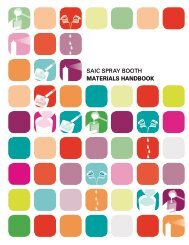i. institutional support and commitment to continuous improvement
i. institutional support and commitment to continuous improvement
i. institutional support and commitment to continuous improvement
You also want an ePaper? Increase the reach of your titles
YUMPU automatically turns print PDFs into web optimized ePapers that Google loves.
I. Institutional Support <strong>and</strong> Commitment <strong>to</strong> Continuous Improvement<br />
B) Institutional assessment<br />
There are a number of institution-wide assessments that are regularly practiced in the course of the<br />
academic year, which include: course evaluations; Curriculum Committee <strong>and</strong> Academic Steering<br />
Committee evaluation of proposed new or altered courses <strong>and</strong> programs; annual budget review;<br />
<strong>institutional</strong> part-time promotion review; part-time faculty evaluations; Full Professor Review<br />
Committee; contract <strong>and</strong> tenure reviews; departmental self-studies; adjunct stabilization review; recent<br />
Strategic Planning Initiatives; <strong>and</strong> two-year formal self-study processes undertaken each decade in<br />
preparation for regional accreditation. The process of the Curriculum Committee is discussed in detail<br />
in section II.2.3 Curriculum Review <strong>and</strong> Development of the APR. The Strategic Planning process is<br />
described in section I.1.4 Long-Range Planning. The remaining examples are described briefly below:<br />
1) Course evaluations<br />
Near the end of every semester, each course at SAIC is evaluated by the students via an anonymous<br />
evaluation form. Students evaluate the faculty, the facilities <strong>and</strong> their own performance. Short<br />
written answers are most common; therefore, these forms are essentially qualitative rather than<br />
quantitative. Faculty members leave the classroom after distributing the evaluations, <strong>and</strong> a student<br />
in the class collects <strong>and</strong> delivers the completed forms <strong>to</strong> the Office of Student Affairs. The most<br />
recent two semesters of evaluations, organized by class, semester <strong>and</strong> instruc<strong>to</strong>r, are available for<br />
students <strong>and</strong> faculty <strong>to</strong> examine. Evaluations from earlier semesters are s<strong>to</strong>red <strong>and</strong>, under certain<br />
restrictions, shared electronically. Evaluations are routinely used in assessing faculty members in<br />
their departments <strong>and</strong> by committees when considering promotions.<br />
2) Budget review<br />
Periodic budget review <strong>and</strong> capital asset requests are also opportunities for departments <strong>to</strong> assess<br />
<strong>and</strong> prioritize their operational needs.<br />
The Deans Office—specifically the Associate Dean <strong>and</strong> the Assistant Direc<strong>to</strong>r of Academic<br />
Administration—meet periodically with Department Chairs <strong>and</strong> Administrative Direc<strong>to</strong>rs <strong>to</strong> evaluate<br />
their departmental budgets, which include both discretionary (e.g. travel <strong>and</strong> research <strong>support</strong><br />
money) <strong>and</strong> operational (equipment, departmental purchases, office expenses, etc.) funds. Annually,<br />
<strong>to</strong>ward the end of the third quarter of each fiscal year, departments may petition the Deans Office <strong>to</strong><br />
redistribute monies among different line items. Final budgets are approved by the Fiscal Office.<br />
Departments may petition Institutional Resources <strong>and</strong> Facilities Management (IRFM) for one-time<br />
capital assets expenses. The Direc<strong>to</strong>r of Facilities Management <strong>and</strong> Budget Planning compiles such<br />
requests, which are filled through committee negotiation including staff from IRFM, the Deans<br />
Office, Fiscal Affairs, <strong>and</strong> the Fiscal Affairs Committee, which is one of the governance committees<br />
of the Faculty Senate. Recent recessionary tendencies in the global marketplace have made this<br />
regular practice an even more incisive opportunity for assessment, as fiscal planning has been more<br />
conservative over the past two years, which is discussed more fully below.<br />
3) Adjunct stabilization<br />
An aspirational goal of SAIC Faculty H<strong>and</strong>book is <strong>to</strong> “strive <strong>to</strong> maintain a ratio as high as possible<br />
of full-time <strong>to</strong> part-time faculty.” The current goal is <strong>to</strong> <strong>institutional</strong>ly move <strong>to</strong>ward a model in which<br />
half of all classes within a department are taught by full-time faculty, with the remaining classes<br />
taught by part-time faculty, half of whom are adjunct faculty. Within the adjunct population, the<br />
School strives for a balanced, stable distribution in which the greatest number of adjuncts are<br />
Adjunct Assistant Professors, with fewer Adjunct Associate Professors, <strong>and</strong> the smallest number of<br />
Adjunct Professors.<br />
41 | Spring 2011<br />
SECTION I Institutional Support <strong>and</strong> Commitment <strong>to</strong> Continuous Improvement



